The Statue Of Equality A Monument Of Universal Significance You Must Explore In 2026
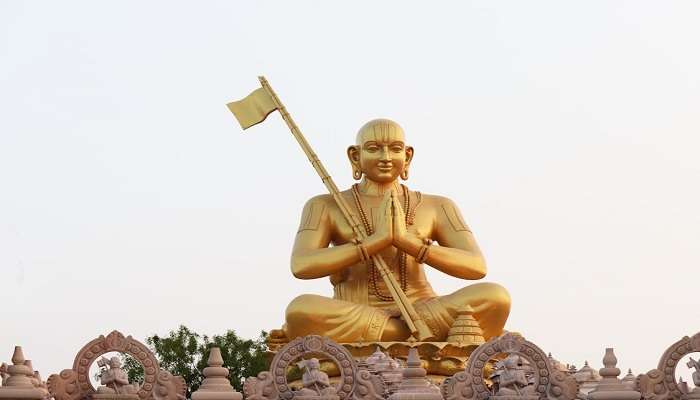
India has its share of iconic statues and monuments, and among the list, The Statue of Equality in Hyderabad deserves to be mentioned. Known to embody the essence of social equality among people, the significance of this statue is truly vital. Beyond its grandeur and economic attributes, the statue represents the country’s historical and cultural heritage. Dedicated to Saint Ramanujacharya, the statue is a reminder of the constant advocacy he preached during his lifetime surrounding the importance of equality among humans. As we witness the beauty and intricacies of The Statue of Equality in Hyderabad, it serves as a reminder to treat everyone equally, irrespective of their social status and class.
About The Statue Of Equality

The Statue of Equality, known as the Ramanuja Statue, is dedicated to the 11th-century Bhakti saint Sri Ramanujacharya. Following his preachings about social equality and universal brotherhood, the statue reminds us to be kind to everyone and treat people equally and with dignity and respect. Construction started a few years ago, but the statue was finally unveiled in 2019 and opened for visitors in the same year. It is one of the tallest sitting statues across the globe, standing at 216 feet.
The primary significance behind the statue’s construction was to commemorate the contributions of Ramanujacharya to Indian philosophy and spirituality. To ensure durability and resilience in the structure, the statue is built using an alloy of five metals, aka panchaloha. While the statue is the focal point of attraction, it lies within the much more giant Statue of Equality Complex, where multiple other attractions, such as a Vedic library, research centre, and educational facility, exist.
Address: 58PM+G7V, Muchintal, Venkannaguda, Telangana 509325
Statue Of Equality entry fees: INR 200 per adult.
Statue Of Equality timings: 05:30 AM to 08:00 PM (weekdays); 05:30 AM to 08:30 PM.
Also Read: Places To Visit In Hyderabad Within 100 KM
What Is The Significance Of The Statue Of Equality?
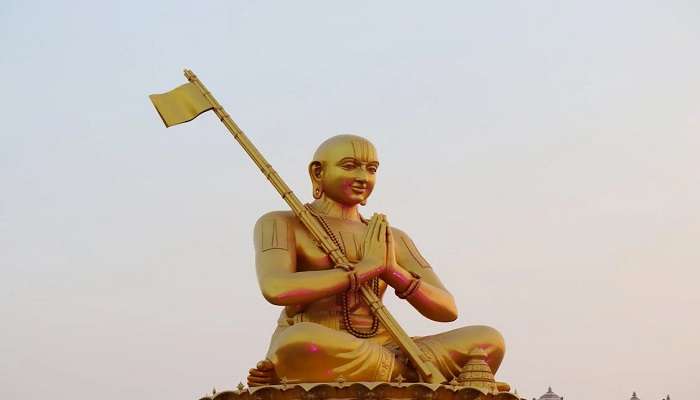
The Statue of Equality holds immense popularity and significance for the following reasons:
Commemorating Ramanuja: The construction and unveiling of the Statue of Equality commemorated the 1000th birthday of the great philosopher and social worker Ramanujacharya. His work on abolishing the caste system and prioritising equal access to education and spiritual knowledge for everyone has shaped our society.
Promoting Social Equality: Despite the revolution that Ramanuja created back in the day, its lessons and requirements are still valid today. So, the existence of this statue serves as a reminder to preach the message of social inclusion further. It reminds us that we must break down social barriers and prioritise building a society of equality and respect for all.
Showcasing Architectural Marvel: The craft and artistic ability of the craftsmen and engineers behind the statue are also worth praising. As mentioned, the statue is built using panchaloha, which adds to its unique charm and reflects the rich heritage of Indian metalwork.
History Of The Statue Of Equality

The origin behind the construction of the Statue of Equality dates back to the vision of Sri Chinna Jeeyar Swamiji, a prominent spiritual leader and a disciple of Ramanujacharya’s teachings. His constant labour and his passion for his teacher made him decide to celebrate his social equality teachings and become more aware of Ramanuja’s work. Using the Chinna Jeeyar Trust, Sri Chinna Jeeyar Swamiji embarked on an ambitious project to erect a statue that would inspire the upcoming generations. With many setbacks, he continued with his dream and his project.
After years of planning, the construction of the Statue of Equality finally kicked off in 2016. It involved the collaboration of multiple artisans, engineers and architects. With discussion, the decision to build the statue using panchaloha was finalised. Beyond its strength, the blend of five metals has promising elements to it as well. With modern engineering practices and unique sculpting abilities, the statue was finally constructed. Later, on February 05, 2019, it was unveiled to the public on the day of the 1000th birth anniversary of Sri Ramanujacharya.
Related Post: Trekking Places In Hyderabad
Architecture Of Statue Of Equality
Beyond the details of the Statue of Equality’s history, learning about the architecture is equally important. Sri Chinna Jeeyar Swamiji coined both the design and concept behind the statue. When discussing the Statue of Equality architecture, there are three primary elements to it:
1. Sitting posture

The statue depicts Sri Ramanujacharya in a sitting posture, reminiscent of him meditating when he was alive. Given that Sri Ramanuja was a spiritual leader, a visionary and a spiritual leader, the sitting posture is significant as it represents all the roles that the saint portrayed when he was alive.
2. Panchaloha construction
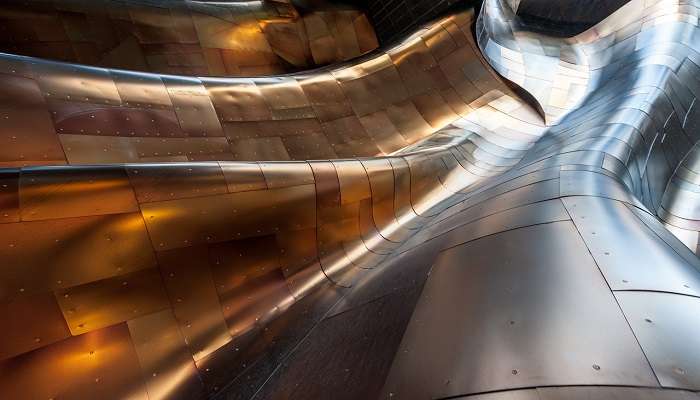
The second important architectural element is the use of panchaloha, or five metals—gold, silver, copper, brass, and zinc. Beyond strengthening the statue’s structure, these five metals also contribute to the spiritual aspect of the whole ordeal.
Related Post: Things To Do In Hyderabad
3. Lotus pedestal
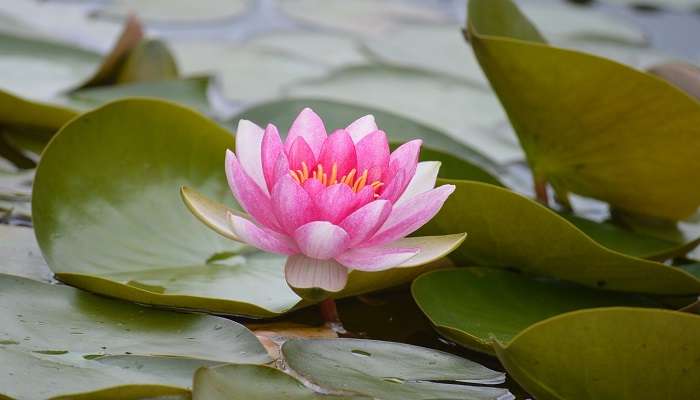
The saint’s statue sits on top of a lotus pedestal, which symbolises purity and spiritual enlightenment. The use of lotus is quite prevalent across Indian art and architecture, and it is also a notable inclusion in this particular statue. Besides the main statue, the surrounding Statue of Equality complex includes other elements that add to the sightseeing spot’s architectural marvel.
Things To Do At the Statue Of Equality
Beyond admiring the Statue of Equality architecture, myriad activities are waiting for your presence. The importance of this statue runs more than the statue itself since there are several experiences around it.
1. Vedic Digital Library

Beyond the physical exhibits we are aware of, the Vedic Digital Library is perfect for individuals who prefer the digitised learning experience. Inside the library, there are digital versions of ancient Indian texts, commentaries, and philosophical treatises that you can stop to read and learn. So, as you step inside, you get to learn specific aspects of Ramanuja’s teachings or explore broader themes of Vedic philosophy in detail.
Highlights: scriptures, commentaries, and related literature, accessible in various formats.
Cultural and Historical Exhibits: Include digital exhibits that showcase the significance of Vedic philosophy, culture, and history, featuring multimedia presentations, interactive timelines, and virtual tours of relevant sites and artefacts.
Related Post: Qutub Shahi Tombs in Hyderabad
2. Research Center

If you are looking to dive deeper into Ramanuja’s teachings, an on-site research centre is available to visit and explore. Dedicated scholars and researchers are already working on Ramanuja’s works and different aspects of social equality. As you explore the research centre, you learn more about it. Most of the scholars even offer guided tours, or you can attend seminars that are held occasionally.
Highlights: Provide state-of-the-art laboratories and collaborative spaces that support research across various fields, including Vedic studies, philosophy, cultural studies, and technology.
Workshops and Seminars: Organise regular workshops, seminars, and conferences featuring experts and scholars to discuss and promote research on Vedic principles, ethics, and their applications in modern society.
3. Exhibition Gallery

Another essential element to stop and explore is the exhibition gallery. You can step back to unveil the rich history and heritage that prevails around Ramanuja and his teachings. This gallery features all the crucial elements that bring Ramanuja’s time to life, from artefacts to paintings and sculptures. Also, the gallery has ancient manuscripts and inscriptions, which are attractive to see up close. Interactive displays are available throughout the gallery from which you can learn more.
Highlights: Curate rotating exhibits that focus on various themes related to Vedic philosophy, spirituality, and culture, using artefacts, multimedia displays, and interactive installations to engage visitors.
Cultural Performances and Events: Host live performances, such as traditional music, dance, or storytelling events, that align with the exhibition themes. This will create a vibrant cultural atmosphere and enhance visitors’ overall experience.
Related Post: Famous Biryani In Hyderabad
4. Temple Complex
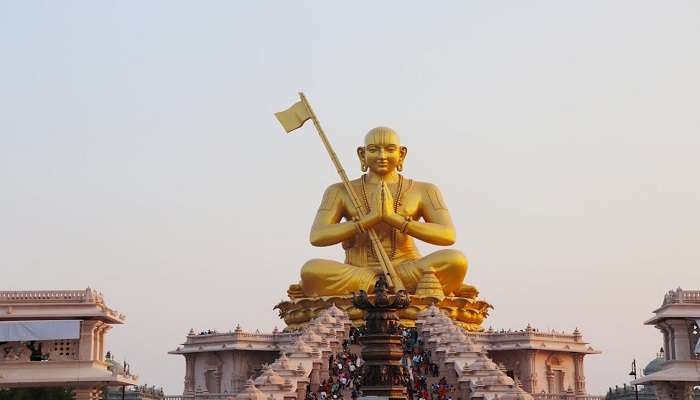
Adjacent to the main Statue of Equality lies a temple complex that houses different Hindu deities. Beyond seeking blessings from the deities, this is also the perfect spot to admire the intricacies and beauty of South Indian temple architecture. Ongoing religious ceremonies occur inside the temple complex, which you can also take part in. If you are curious to learn more about the spiritual and religious aspects of Ramanuja’s teaching, visiting this temple complex provides a bit of an idea of the same as well.
Highlights: Include designated areas for meditation and spiritual practice, such as tranquil gardens, meditation halls, and serene water with a peaceful environment.
Cultural and Spiritual Events: Organise regular religious ceremonies, festivals, and spiritual gatherings that promote community engagement and allow visitors to participate in the vibrant traditions and practices associated with the teachings of equality and unity.
You May Also Like To Read: Trekking Near Hyderabad
The Statue of Equality Hyderabad is one of the city’s most alluring and unique sightseeing spots. With its historical and cultural significance, the existence of this statue and the complex reminds us of Ramanuja’s teachings and his drive towards an equal society without the complexities of caste-based, income-based disparity. The next time you plan a trip to Hyderabad, visiting this statue complex is a must.
For our editorial codes of conduct and copyright disclaimer, please click here.
Cover Image Source: Pexels
Frequently Asked Questions About Statue Of Equality
How tall is the Statue of Equality?
The statue is 216 feet tall, making it one of the tallest sitting statues in the world.
What is the entry fee for the Statue of Equality?
The Statue of Equality entry fee is INR 200 per adult.
What materials were used to construct the Statue of Equality?
The Statue of Equality uses panchaloha, which translates to five metals. It includes gold, silver, copper, brass, and zinc.
What other attractions are near the Statue of Equality?
Once you finish exploring the Statue of Equality, make your way to the nearby sightseeing spots including Charminar, Ramoji Film City, Golconda Fort, Salar Jung Museum, Hussain Sagar Lake, and Nehru Zoological Park.
What is the Statue of Equality best time to visit?
The Statue of Equality's best time to visit is during the colder winter months, from October to March.
People Also Read:
Buddha Statue Hyderabad Statue Of Unity Statue Of Liberty

Unveil the hidden treasures of the globe and turn every travel dream into reality. As a Content Writer, I am passionate enough to craft stories from ancient wonders to modern marvels. My words paint the picture-perfect itinerary for unforgettable experiences. Let my words be your trusted guide to immerse in the diverse culture and discover the beauty of the unknown.











